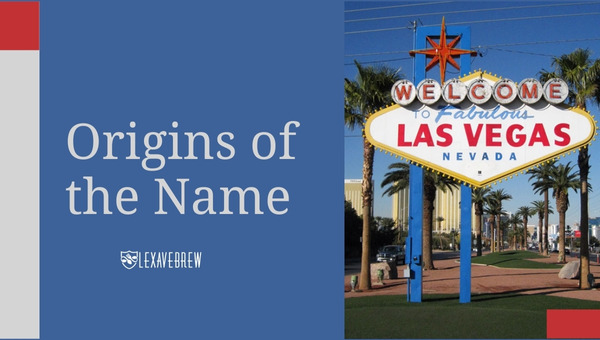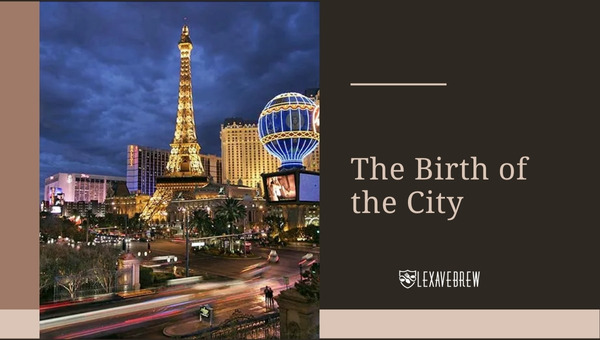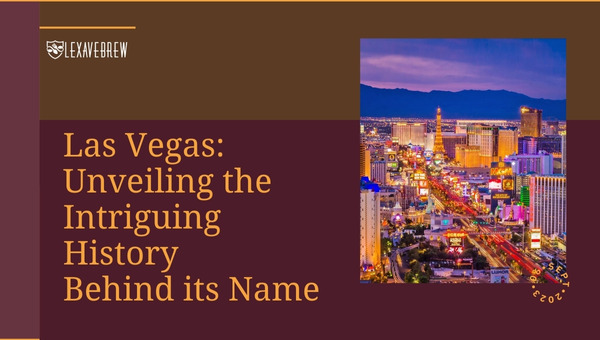Las Vegas, a name that conjures up images of dazzling lights, vibrant casinos, and non-stop entertainment. But have you ever wondered what lies behind this intriguing name?
Join me on a journey as we unravel the fascinating history of Las Vegas, uncovering the origins and meanings hidden within this iconic city’s name.
From its humble beginnings as a desert oasis to its transformation into the ultimate playground for adults, we’ll explore the tales and legends that have shaped Las Vegas into the mesmerizing destination it is today.
So, please sit back, relax, and dive into the captivating story of what Las Vegas truly means.
Also Read: Las Vegas Gambling Age
Origins of the Name
The history behind the name Las Vegas is quite fascinating and dates back to the early 19th century. Let’s break it down to understand its origin and uncover where it all began.

In Spanish, “Las Vegas” translates to “The Meadows.” The city received this name because of its location in the middle of the desert with underground water supplies, which led to rich agricultural lands.
Las Vegas was initially discovered by a Spanish trading party led by Antonio Armijo in 1829. This was during their journey along the Old Spanish Trail, a popular trade route between Santa Fe and Los Angeles.
It’s important to mention that at the time, the Las Vegas Valley was populated by several Native American tribes, such as the Southern Paiute and the Pueblo people. The Native American presence in the region predates the arrival of the Spanish explorers by thousands of years.
As for the name itself, it’s easy to see why early explorers chose it:
- Underground water sources: Despite the arid desert climate, Las Vegas boasts natural springs and an underground water system that once provided lush meadows fed by these waters.
- Fertile land: The water availability made the area a prime location for farming and attracted various settlers.
Later, in the 1840s, John C. Frémont, an American explorer and politician, documented his experiences in the Las Vegas Valley during one of his expeditions and popularized the name even more.
However, Las Vegas wasn’t officially recognized as a city until 1905, when the establishment of the railroad led to its expansion as a bustling town. Here are some key dates in Las Vegas history:
| Year | Event |
|---|---|
| 1829 | Antonio Armijo and his trading party discover Las Vegas. |
| 1844 | John C. Frémont documents his expedition in the region. |
| 1855 | LDS Church establishes a temporary settlement in the area. |
| 1905 | Las Vegas is founded. |
| 1931 | Construction of the Hoover Dam begins, attracting workers and boosting the economy. |
In the late 18th century, Spanish explorer Antonio Armijo was on an expedition to find a new trade route between Santa Fe and Los Angeles, following the Old Spanish Trail. What he stumbled upon would later become the world-renowned city of Las Vegas.
The Spaniards named this area “Las Vegas,” meaning “The Meadows” in English. This name reflects the valley’s fertile nature due to its plentiful water supply fed by natural springs.
The springs in the area were part of a larger underground river system, which provided much-needed water to support various plant and animal life.
These resources attracted the attention of the Paiutes, a native tribe that lived in the area for centuries. Some key points about the area back then include:
- The name Las Vegas comes from the Spanish phrase “Las Vegas de Santa Fe”, with Vegas meaning meadows or fertile plains.
- The valley was a key point on the Old Spanish Trail, a trade route linking Santa Fe to Los Angeles.
- The presence of natural springs made Las Vegas an important stopping point for travelers on their way to California.
Las Vegas has come a long way from its humble beginnings as a verdant oasis amid the Mojave Desert. While the name’s origins reflect the area’s bountiful water resources, it’s synonymous with glamour, entertainment, and excitement today.
Despite this transformation, the history of the Las Vegas name continues to evoke a sense of wonder for those who take the time to learn about its roots.
The Birth of the City
Las Vegas, the glitzy gambling hub we know today, had a modest beginning. The city was founded in 1905 as a small railroad stop and gained its name, which translates to “The Meadows” in Spanish. Before diving into how this iconic destination evolved, let’s take a look at some significant events that shaped its early history:

- Naming the City: Las Vegas was named by Spaniard Antonio Armijo, who discovered the area during his trade journey between Santa Fe and Los Angeles in 1829. The verdant valley with abundant water sources perfectly contrasts the surrounding desert landscape, thus earning the title Las Vegas.
- Land Auction: On May 15, 1905, the city was officially born with a land auction that initiated its expansion. One hundred ten acres of land were sold at this auction, marking the establishment of downtown Las Vegas.
- Establishing Infrastructure: The Las Vegas railroad, particularly the San Pedro, Los Angeles, and Salt Lake Railroad, played an essential role in the city’s growth. It connected Las Vegas with other cities and provided much-needed water supplies, boosting the town’s population and economy.
Here’s a markdown table showcasing some important dates in Las Vegas history:
| Year | Event |
|---|---|
| 1829 | The area is discovered and named Las Vegas by Antonio Armijo |
| 1905 | Las Vegas is founded, and a land auction marks its expansion |
| 1911 | Las Vegas is officially incorporated as a city |
Fast-forward to the 1930s, a significant change was just around the corner. Nevada legalized gambling in 1931, and Las Vegas entered the limelight as a gaming paradise. Coupled with the construction of the Hoover Dam nearby, the city’s population steadily increased, making way for various casinos and resorts.
Of course, the most notable development in its history was the construction of the famous Las Vegas Strip in the 1940s. As casinos and resorts sprang up across the Strip, it soon became the entertainment epicenter, drawing millions of worldwide visitors.
Overall Las Vegas has come a long way from being a simple railroad stop to becoming the thriving metropolis it is today. Its name, historical events, and local developments have all played a crucial part in creating the city’s unique identity.
Also Read: Why Las Vegas is called Sin City
Entering the Gambling Realm
Las Vegas wouldn’t be what it is today without its vast array of casinos and resorts. But how did it become the gambling capital of the world? Let’s dive into the history and explore how Sin City became synonymous with gambling.

The seed for the gambling scene in Vegas was planted during the 1920s and 1930s when illegal gambling hubs started popping up around the city.
These underground establishments were the precursors to the glitzy casinos we know today. Nevada’s decision to legalize gambling in 1931 set the stage for an incredible transformation.
In the following years, several casino hotels started taking shape on what is now known as the Las Vegas Strip.
The legendary El Rancho Vegas was the first of these, which opened its doors in 1941. This marked the beginning of the age of casino resorts in the city. Some of the most iconic casino resorts that followed include:
- Flamingo (1946)
- Desert Inn (1950)
- Sands (1952)
- Caesars Palace (1966)
- Circus Circus (1968)
One fascinating thing about the casino boom in Las Vegas is its connection to organized crime. Many of the early casino developers had ties to the mob, including Bugsy Siegel, who played an instrumental role in the development of Flamingo.
Although the mafia’s influence on Las Vegas eventually diminished due to government crackdowns, its legacy can still be felt in some parts of the city.
Las Vegas grew as the years went by, attracting countless visitors worldwide. People came to be dazzled by the bright lights of the Strip, take part in high-stakes gambling, and revel in the city’s one-of-a-kind entertainment options.
One of the key factors contributing to Las Vegas’ rise as a gambling paradise was its continuous evolution. The city embraced change and innovation, always striving to offer its guests the best experience possible.
This led to the evolution of casinos into extensive entertainment complexes with limitless amenities, such as nightclubs, restaurants, and even theme parks.
Here are some exciting facts about the gambling scene in Las Vegas:
- Biggest Win: A lucky player won $39.7 million at the Excalibur Casino in 2003, marking the city’s largest jackpot.
- Mega-resorts: Las Vegas is home to 15 of the world’s 25 largest hotels, showcasing its dedication to extravagant hospitality.
- Annual Gambling Revenue: The gambling industry in Vegas generates approximately $10 billion in annual gaming revenue.
Today, Las Vegas stands as the undisputed gambling capital of the world. With its luxurious resorts, unforgettable entertainment, and non-stop action, it’s easy to see how Sin City transformed from a small desert settlement into the epitome of excitement it is today.
Las Vegas Iconic Strip
When it comes to Las Vegas, one thing instantly comes to mind: the iconic Strip. But there’s more to explore beyond its glittering surface. Here, I’ll dive deeper into the history and significance of the Las Vegas Strip that we all know and love.

The Las Vegas Strip stretches South of Las Vegas Boulevard, approximately 4.2 miles. Known for its vibrant nightlife, casinos, and luxury resorts, this famous locale didn’t always exist as we see it today.
It all started in 1941 when the first casino in the area, El Rancho Vegas, opened its doors. The widely successful venture attracted more developers to the area, laying the foundation for the gambling mecca we know today.
Fun facts about the Las Vegas Strip:
- The Strip isn’t entirely in Las Vegas; it runs through the neighboring Paradise and Winchester towns.
- It’s home to 15 of the world’s 25 largest hotels by room count. Collectively, they offer more than 62,000 rooms to visitors each year.
Here’s a table showing some of the famous hotels and casinos that have helped shape the Las Vegas Strip:
| Hotel/Casino | Opening | Notable Features |
|---|---|---|
| Flamingo Las Vegas | 1946 | First luxury resort on the Strip |
| Caesars Palace | 1966 | Features Roman-inspired architecture |
| Bellagio | 1998 | Known for its opulence and iconic fountain show |
| Mandalay Bay | 1999 | Houses an artificial beach and aquarium |
| The Venetian | 1999 | Showcases Venice-inspired design with canals and gondolas |
Through the years, the Strip has undergone many transformations. Notable events include:
- In the 1960s, the Mafia played a significant role in the Strip’s development.
- In the 1980s and 90s, there was a shift towards more family-friendly attractions.
- In recent years, a new wave of luxury properties and upscale shopping venues has redefined the Strip.
The Las Vegas Strip is a continuously evolving landmark deeply rooted in history. From its humble beginnings in the 1940s to its current status as a global entertainment hub, the Strip has come a long way. As time passes, we can only anticipate more changes for this iconic symbol of luxury and excitement.
Also Read: Cosmopolitan Las Vegas Pool
The Golden Age of Entertainment
Let me take you back to the golden age of entertainment in Las Vegas. With the legalization of gambling in 1931 and the construction of the Hoover Dam, Las Vegas began attracting visitors from all over.
But it wasn’t until the late 1940s and 1950s that Las Vegas truly began to shine as an entertainment destination.
Casinos and resorts during this era were hesitant to reveal exact numbers, but it’s clear that these booming establishments attracted millions of visitors throughout the 1950s and 1960s.
The golden age of entertainment also introduced production shows, with spectacular performances featuring dancers, singers, and other variety acts.
These shows were designed to be lavish and unforgettable experiences for guests. Some famous production shows from this time include:
- Folies Bergère: This enduring Vegas classic debuted at the Tropicana in 1959 and entertained audiences for nearly 50 years.
- Jubilee: A staple at Bally’s between 1981 and 2016, this extravagant production featured talented showgirls adorned in elaborate, sparkling costumes.
As Las Vegas evolved and expanded, the city became more attractive to families, with hotels creating more family-oriented attractions.
Examples include theme parks, like the now-demolished Wet ‘n Wild water park, and the introduction of luxury shopping destinations like the Forum Shops at Caesars Palace.
With these new developments, the entertainment focus of Las Vegas began shifting towards a more inclusive experience.
Modern-Day Sin City
Las Vegas is often called Sin City today due to its abundance of adult entertainment, gambling, and nightlife. But how did it get this nickname? Let’s dive into its origins and transformation into the Vegas we know and love today.
One of the major factors contributing to Las Vegas’s evolution into a sin city was the legalization of gambling in Nevada in 1931.
This development drew mobsters and organized crime figures, who saw the potential for great profits. They started investing in the area, constructing lavish and opulent casinos along Fremont Street, which would later become the famous Las Vegas Strip.
Another key moment occurred in the 1940s and 1950s when the U.S. government began testing atomic bombs at a site approximately 65 miles northwest of the city. People flocked to Vegas to witness these awe-inspiring explosions, creating what some called the Atomic Tourism boom.
Las Vegas’s reputation as a city of indulgence was further solidified in the 1960s when the infamous Rat Pack — a group of entertainers featuring Frank Sinatra, Dean Martin, and Sammy Davis Jr. — brought their brand of glitz and glamour to Sin City’s stages. Visitors worldwide flocked to the desert oasis to glimpse these iconic stars.
Las Vegas continues to thrive as a global tourist destination, renowned for its gambling and decadent offerings and world-class dining, shopping, and spa experiences.
An ever-evolving lineup of residencies and performances from top musicians and artists has cemented Sin City’s status as a premier destination for entertainment-seekers.
Recent Growth and Expansion
In recent years, Las Vegas has experienced impressive growth and expansion. The city’s population skyrocketed from around 100,000 in the 1970s to nearly 650,000 in 2020. Various factors, including a booming tourism industry, affordable housing, and favorable tax policies, fueled the rapid demographic change.
The recent growth and expansion can also be attributed to some notable factors:
- The influx of new businesses: Besides the gaming and hospitality industries, Las Vegas has attracted companies from various sectors, such as technology, healthcare, and manufacturing. These new establishments generated more job opportunities and ultimately fostered population growth.
- Major construction projects: Several large-scale construction projects have been undertaken in the city, including the construction of the $4.3 billion Resorts World Las Vegas, the recently completed Allegiant Stadium, and the expansion of the Las Vegas Convention Center. These projects signify the city’s commitment to growth and its constant evolution to remain a top destination for tourists and residents alike.
- Increased accessibility: Las Vegas has become more accessible through transportation improvements. The city’s international airport, McCarran International Airport, has expanded its flight capacity, and completing the Interstate 11 project has enhanced connectivity between Las Vegas and other important regional destinations.
- Cultural evolution: As the city has grown, it has evolved culturally. Las Vegas now boasts world-class entertainment options, museums, and galleries, attracting visitors and new residents drawn to the city’s arts and culture scene.
Here’s a table showcasing the city’s population growth over the years:
| Year | Population |
|---|---|
| 1970 | 125,787 |
| 1980 | 164,674 |
| 1990 | 258,295 |
| 2000 | 478,434 |
| 2010 | 583,756 |
| 2020 | 641,903 |
It’s important to note that with this recent growth and expansion comes new challenges for Las Vegas, such as infrastructure development, affordable housing, and focusing on environmental sustainability.
Nevertheless, the city continues to forge ahead, adapting and finding new ways to manage its growth while maintaining its unique appeal and identity.
Interesting Facts About the Name
Many people have contemplated Las Vegas’s name’s origins, but few know its history. Las Vegas got its name from Spanish explorers who named the lush valley “la vega,” which translates to “the meadow” in English.
This section delves into some fascinating tidbits about the name’s history that you might not know.
1. Las Vegas wasn’t always the city of lights and casinos:
Before the iconic casinos and bright neon signs, the area now known as Las Vegas was home to Native American tribes and lush springs.
In 1829, Rafael Rivera, a Mexican scout, and explorer, discovered the valley and named it after the meadows sustained by underground wells. This rich history is often overlooked in favor of the glitzy present-day attractions in Sin City.
2. The railroad’s role in Las Vegas’ development:
Las Vegas was a significant stop between Los Angeles and Salt Lake City when the railroad industry thrived. 1905 the city was officially founded and quickly became a vital transportation hub.
3. The unexpected influence of Hollywood:
In the 1930s, Las Vegas saw a significant influx of visitors from Hollywood, particularly during the construction of the Hoover Dam. Actors and crew workers would visit the casinos after a long day on set. This connection with Hollywood helped Las Vegas become its entertainment capital today.
With this information in mind, it’s fascinating to understand how the rich history behind Las Vegas’ name contributed to its development as an iconic destination.
The valley, once known to explorers as “la vega,” has certainly come a long way, transforming from a lush meadow to the glittering entertainment capital of the world.
Also Read: Best Las Vegas Breweries
Conclusion
Diving into the history of Las Vegas’ name helps provide further context about the city we know today. Originally, Las Vegas was a name given by a Spanish traveler to describe the meadows in the region.
As time went on, the name became synonymous with the bustling, world-famous city we know today. The history of Las Vegas’ name contributes to the vibrant and diverse tapestry that is the city’s present.
Overall, understanding the history behind the name of Las Vegas gives us insight into the city’s beginnings, its remarkable journey, and the cultural influences that have shaped it.
By exploring the meaning of Las Vegas, we can better appreciate the rich story behind one of the world’s most reinventing and captivating cities.

